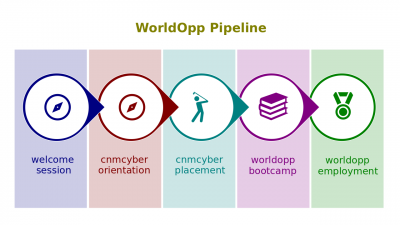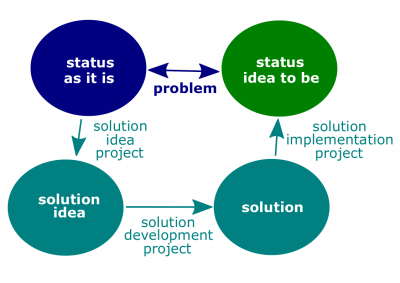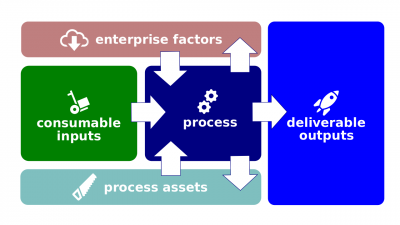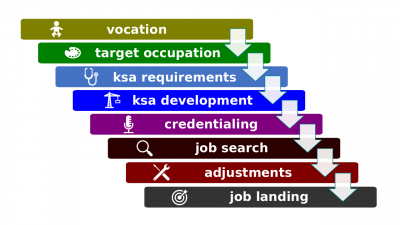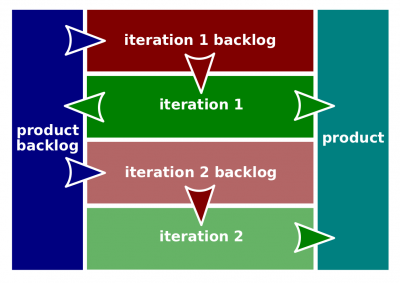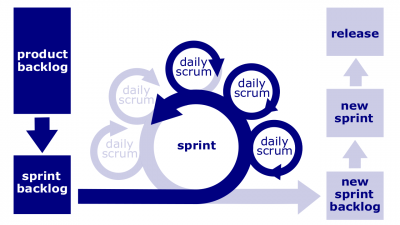Career Endeavors
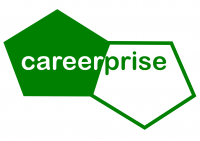
Careerprise's trade mark
Career Projects is the second presentation in the Introduction to Careers lecture. The lecture itself is the fourth in WorldOpp Orientation. Consequently, the Orientation is the first stage of WorldOpp Pipeline.
This wikipage presents its full script and those test questions that are related to that presentation.
Contents
Script
The video of the presentation is published at https://youtu.be/lT20y2GMJws (12:39). Here is its full text.
Overview
- Welcome to Career Projects. In this brief presentation, we are going to define projects and take a look at two major methods that employment candidates can use in order to land their promising jobs.
What a project is
- Let's start with a question. What may employment candidates borrow from business administration in order to advance their careers? Projects are an obvious choice.
- Enterprises tend to run two types of operations -- one is ongoing, established, repetitive, and the other aim to create something new. Is employment desired? If so, we can state that you are in a project of landing your job.
- To understand projects better, let's take a look at the available illustration. There are two statuses -- one on the upper left is as it is and another on the upper right is to be. The difference between these two is called a problem to be solved. There should be some solution, but usually that solution needs to be yet identified.
- Many projects are nesting. Solving a problem is a project, but creating a solution or even development of an idea for the solution are by the definition projects too. To indicate that they are parts of a bigger projects, they can be called project phases. And all of them include one or more processes, which can be considered as the smallest project.
What a process is
- A process is a sequence of activities undertaken in order to achieve particular results. Systems engineers may also define a process as converting inputs into outputs using some tools and techniques while being influenced by enterprise factors.
- Does it sound complicated? If you collected all available information and need to create an idea of a solution, your time would be an input, information would be your tool, decision-making methods would be your techniques, legal and ethical considerations can be your factors, and an idea would be your output.
Project administration
- Administering projects particularly includes sequencing processes, and project phases that are required in order to accomplish a project. There are several approaches and, in this presentation, we will consider two major ones.
Job search as a waterfall
- A traditional model is called the career waterfall. Many career counselors may recommend this route.
- Waterfall refers to a sequential process where progress is seen as flowing steadily downwards through the phases. These phases may vary, but often consist of, a, discovering one's vocation, bee, suggesting one's target occupation, see, identifying work-related competence needed for a particular position, dee, development of one's KSAs, ee, development one's employment credentials, eff, job search, gee, adjustments to the job market, and, aitch, landing one's job in the target occupation.
Lisa in Waterfall
- Let's add some real life example; just the name is changed to preserve the privacy. Meet Lisa, who used to believe that management was her vocation. Her parents believed in that too. She attended a college for 4 years to earn an academic credential in operations management with concentration in managerial accounting, but no one wanted to hire her because of her lack of work experience. She started working as a sales representative and eventually stays in that occupation till now. She doesn't regret about her 4 years in a college, and says that it was fun, but she has never managed any operations using managerial accounting in her career.
- That example is not everyone's case, and some waterfall projects can be successful, but there is no way that everything in that many-years project would go as planned and a great chunk of time -- and often money -- wouldn't be wasted.
Agile job search
- Agile is another methodology of administering projects. An Agile project is usually completed in several iterations. In different models these development cycles can also be called sprints and scrums. The results of each iteration shall be used to setup objectives for other iterations. So, instead of one huge and costly project without clear understanding of its outcome, the Agile methodology offers many smaller trials and, sometimes, fails in order to clarify objectives while on the way.
Lisa in Agile
- Let's imagine that Lisa from the example above used Agile. She had some vocation for management and accounting. Not to start from scratch, she also had some knowledge, skills, and abilities. She probably knew at least 50% of basic bookkeeping from her first semester in her college.
- In the tax season, she could have started looking for a job of an entry-level bookkeeper. If it is not the tax season, she could volunteer as a manager and or bookkeeper, so she would test whether those fit her vocation. She will put her hands on something she dreamed about and have a feeling whether she wants to continue or do something that in the Agile methodology is called "pivot."
- At any rate, in 4 years, Lisa would have a 4-year degree, 3 years of experience and an actual job.
- The most important feature of the Agile job-search map is that a big project is chunked in many smaller ones and results in one can define objectives for another.
Summary
- This concludes the Career Projects presentation. We have defined projects and taken a look at the career waterfall and Agile methodology. If you haven't done yet so, you are now welcome to move to Job Search Map.
Quiz questions
- Every statement below is split into one true and one false question in the actual exam.
See also
- Job Search Map. The third presentation in Introduction to Careers.
- Career Essentials. The first presentation in Introduction to Careers.
